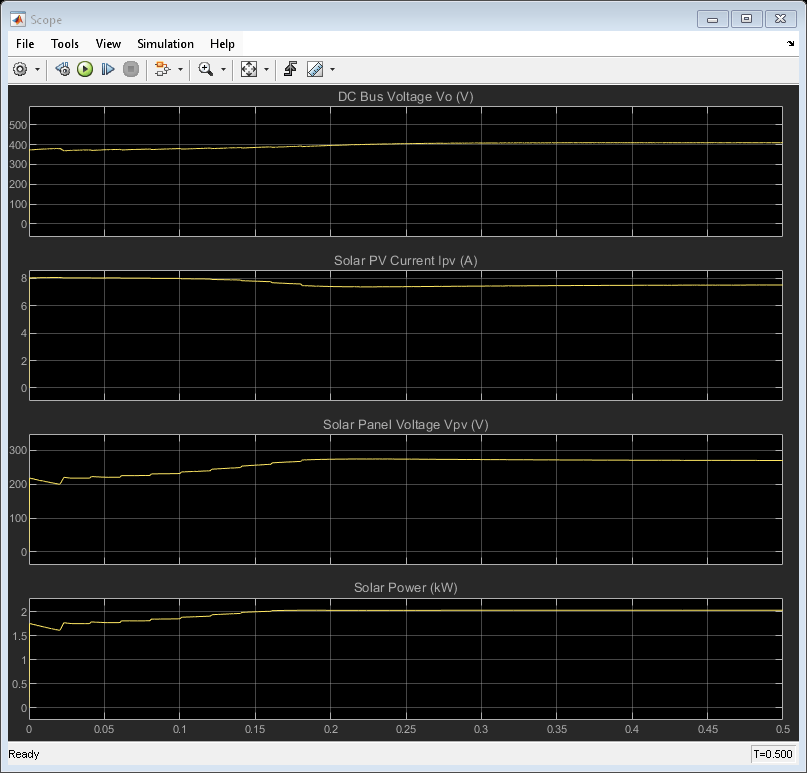采用升压转换器的 MPPT 太阳能光伏系统
此示例展示了用于控制太阳能光伏 (PV) 系统功率输出的升压转换器的设计。在本示例中,您将学习如何:
确定如何排列电池板,包括串联组串数和每个组串的电池板数量,以实现所需的额定功率。
使用升压转换器实现最大功率点追踪 (MPPT) 算法。
在电压控制模式下运行太阳能光伏系统。
为 PI 控制器
 选择合适的
选择合适的 proportional增益 和
和 phase-lead time constant 。
。
DC 负载连接在升压转换器输出两端。太阳能光伏系统在最大功率点追踪模式和降额电压控制两种模式下运行。为了追踪太阳能光伏系统的最大功率点 (MPP),您可以在两种 MPPT 方法之间进行选择:
增量电导法
扰动观察法
您可以指定输出 DC 母线电压、太阳能光伏系统工作温度和太阳能电池板规格。您可以使用太阳能电池板制造商数据来确定所需的光伏电池板数量,以满足指定的发电能力。
采用升压转换器的 MPPT 太阳能光伏系统
要打开“采用升压转换器的 MPPT 太阳能光伏系统”示例的设计脚本,请在 MATLAB® 命令行窗口中输入:edit 'SolarPVMPPTBoostData'
所选太阳能光伏电站参数如下:
*********************************************************************************************** **** PV Plant Parameters for the Specified Solar Panel **** *********************************************************************************************** *** Power rating input from the user = 2.00 kW *** Minimum number of panel required per string = 8 *** Maximum number of panel connected per string without reaching maximum voltage = 10 *** Minimum power rating of the solar PV plant = 1.80 kW *** Maximum power possible per string without reaching maximum DC voltage = 2.25 kW *** Actual number of panel per string = 9 *** Number of strings connected in parallel = 1 *** Actual solar PV plant power = 2.03 kW ***********************************************************************************************

Solar Plant 子系统
Solar Plant 子系统对包含太阳能电池板并联组串的太阳能光伏电站进行了建模。Simscape™ Electrical™ 库中的 Solar Cell 模块对太阳能电池板进行建模。系统会根据指定的 DC 母线电压、太阳能电池特性和指定的额定功率来计算每个太阳能电池板组串的长度以及并联组串的数量。连接多个电池板会增加模型中的元件数量,从而减慢仿真速度。通过假设所有太阳能电池板具有均匀的辐照度和温度,Solar Panel 子系统可以使用受控电流和电压源来减少太阳能元件的数量。

最大功率点追踪 (MPPT)
此示例通过使用可变子系统实现了两种 MPPT 方法。将变体变量 MPPT 设置为 0 可选择扰动观察法 MPPT 方法。将变量 MPPT 设置为 1 可选择增量电导法。
中间升压 DC-DC 转换器
此示例使用升压 DC-DC 转换器来控制太阳能光伏功率。升压转换器在 MPPT 模式和电压控制模式下运行。仅当负载功率小于太阳能光伏电站在给定入射辐照度和电池板温度下能产生的最大功率时,模型才使用电压控制模式。

仿真输出(MPPT 模式)
